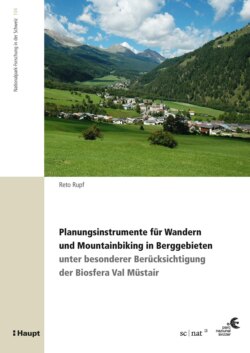Читать книгу Planungsinstrumente für Wandern und Mountainbiking in Berggebieten - Reto Rupf - Страница 7
ОглавлениеAbstract
Leisure time and recreation are gaining importance in many people’s lives, while natureoriented outdoor sports are becoming more popular. Destinations in the Alps have therefore introduced new infrastructures and marketing campaigns to encourage hiking and mountainbiking, in order to increase the revenue from summer tourism in the face of climate change. However, as increased visitor numbers impinge on habitats of rare species, on landscape and create potential user conflicts, optimal planning and integrated area management are needed.
Agent-based models (ABM) offer new computer tools that simulate independent actions by individuals (agents) and could be used in planning and management. The agents base their actions on rules relating to their environment and to other agents. The speciality of this study is the development of a methodology to derive agents’ rules regarding the design of an ABM for mountain regions in the field of nature-oriented outdoor sports with a view to optimizing the planning process. It demonstrates a manner of an integrated management of two different outdoor recreation activities, hiking and mountainbiking.
In this study the rules required for an ABM are defined by Discrete Choice Experiments (DCE) with outdoor recreationists in order to emulate decision-making situations encountered by hikers and mountain bikers as realistically as possible. Central elements of the experiments are tour decisions, visualized by maps and profiles, and decisions at trail junctions. Real trip data is used to adjust the DCE. For this purpose 772 hiking and 223 mountain biking tours were recorded with GPS-Loggers in the Biosfera Val Müstair and the data analyzed using a Geographic Information System.
The responses of 948 hikers and 317 mountain bikers to the DCE questionnaire showed that hikers and mountain bikers can each be divided into different recreational types, that is, two preferring short and two preferring long trips, each with specific parameters for the agents concerned. The subsequent application of multinominal logit model allows for the development of decision support systems (DSSs) which can be used to validate the attractiveness of a destination’s and protected areas’ tour and trail supply. Such DSSs are user-friendly planning tools.
This study shows how DCE can be applied to create a tailored base for ABM. To elaborate new infrastructure for nature-oriented outdoor sports in mountain regions the ABM should be enhanced.
Keywords
Discrete choice experiment, agent-based model, GPS-logging, environmental planning, outdoor sports, hiking, mountainbiking, recreation, visitor management, destination development, trail network, mountain regions, Alps, protected areas, Biosfera Val Müstair
